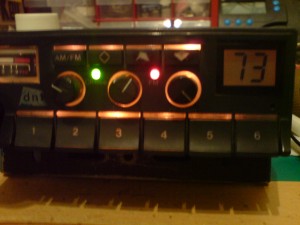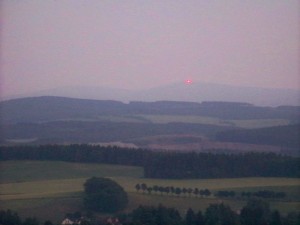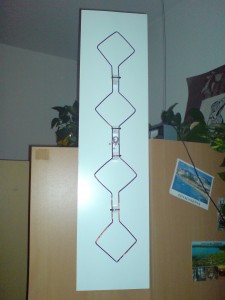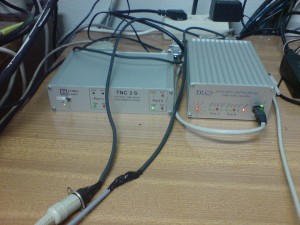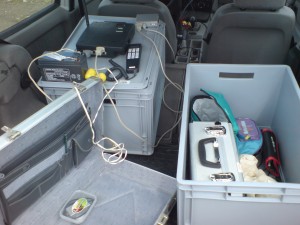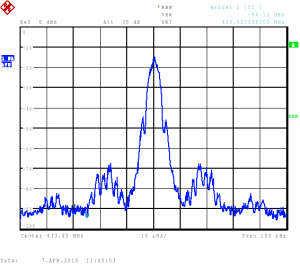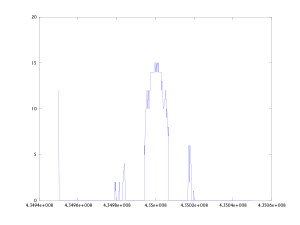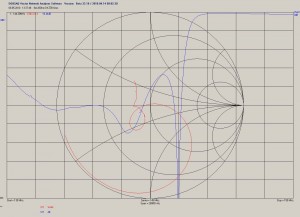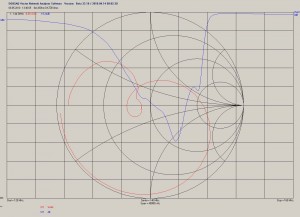Some weeks ago i found an interesting webpage. At funkservice.at Gerhard offers PLL modules and DDS modules that fit to the LC7132 pinout of old CB radios. With these modules you can change your old 40 channel CB radio into an 80 channel version. I did this with my old dnt Carat exclusiv which was one of my very first radios that i ever owned. Now it has full 80 channels.
Unfortunately with this modification it lost its operating permission :)
But i am writing these lines because Gerhard also offers modules to modify old CB radios for FM usage within the 10m amateur band FM range. The modules will do automatic repeater shift within the 10m repeater frequencies.
This might be a good way to get some activity to this band using old CB rigs for doing some local qso on 10m in FM.
It is also a chance to support newcomers with transceivers that cost just a few Euro.
Category Archives: Amateur Radio
D-Star under impulse noise conditions
Last week DL3OCK generated a testfile for me. This file contains an FM signal and an D-Star signal with 50kHz offset. It can be transmitted with special equipment. I used this to check the behavior of my C5 70cm transceiver close to noise level and with impulsive noise. Find the videos below.
http://www.youtube.com/v/0Zz1Qd5ch4A
This video shows the comparison between D-Star and FM at around -115dBm.
It is clearly audible that D-Star has some advantages against FM if the decoder can stay in sync. The microphone of the camera does not represent the FM very well. In reality the FM sound was slightly better.
http://www.youtube.com/v/0mD1gWB2B58
This video shows the performance of FM vs D-Star under impulsive noise conditions. It is clearly audible that D-Star works without problems when FM is hard to understand.
DM7A team July Contest 2010 in JO60LK / 38km laser contact
last weekend i participated in the V/U/SHF contest within the DM7A contest group. We were qrv from JO60LK (mountain Fichtelberg). This time Murphy was definitively with us. Problems with the mains supply, defect power supplies, missing rotary controller, defect 23cm rig, no chance to get german UMTS network… Not even the german DVB-T network could be received from our location at the Small Fichtelberg. We had to view the soccer game DL-LU in OK TV ;)
Find some pictures here:
http://dh5ym.hopto.org/DM7A/DM7A_Jul10/thumb.html
In the evening we tried Laser from Fichtelberg to the Dittersdorfer Hoehe near Chemnitz. The laser light from DK5WMA was visible immediately after switching on. The opposite direction worked as well after adjusting the direction on my side.
The signal was really strong but with heavy fast QSB due to the very humid air. We did the contact in CW. Find below a picture and a short video of my CQ loop that were taken by Marcel.
http://www.youtube.com/v/Au8nCtY_mjk
The following video shows how the laser of DK5WMA was seen in JO60LK. Of course the light was much brighter. The camera sensor seems not to take the green light very well. The flickering has its origin in the high air humidy and moving air because of some wind. The light was sent with constant amplitude at this moment.
Quados4 23cm dimensions
On special request here the dimensions i used for my quados4 antenna. For further information please see the pages of YU1AW.
It has to be mentioned that the dimensions appear to be a bit too long which can be seen from the measurement below.
This is although the element was manufactured of 2mm diameter wire.
Datenfunk Treffen 26.06. – Nachlese
Am letzten Samstag fand in Dresden ein Treffen zum Thema Datenfunk im Amateurfunk mit Schwerpunkt Hamnet statt. Ab 9 Uhr gab es Gelegenheit, sich zu Technik zu informieren und rege über Planungen für die nächste Zeit zu diskutieren. Die 16 Teilnehmer kamen aus Sachsen-Anhalt, Sachsen, Brandenburg und Berlin.
Mehr Informationen sind in der Yahoo Gruppe http://groups.yahoo.com/group/digafusax/ zu finden.
23cm Quados4 antenna
Some time ago YU1AW published some documentation about his experiments and simulations with stacked quad elements for 13cm. He optimized the stacked quad design by changing the distances of the quad elements by using parallel wires in between. He showed that these antennas show some improvements against traditionally stacked bi-quad elements were the distance is too low. He published data for 4 quad element antennas (Quados4), such with 6 quad elements and with 8 elements.
DF9IC published some results with the 8 quad element version recalculated for 23cm. This year DH1FM built two of these Quados 8 antennas for 23cm and used it successfully in contest operation.
To get a feeling of this antenna type i built the Quados4 antenna for 23cm. A big problem for me was to get it somehow mechanically stable. The accuracy of the quarter lambda transformer and the big distance between the wires at the feedpoint showed some difficulties as well. In the end the antenna seems to work and brings close to 6dB better results than my biquad antenna. But in fact it seems that the distance between the reflector and the antenna element is still too large because it improves if the end elements are bent towards the reflector.
Find some pictures below.
For the future i will try to build a 2x Quados4, means two of the elements above side by side.
DLC7 hardware at DB0TUD digipeater
Since friday/saturday the digipeater DB0TUD operates with a DLC7 (data link controller). This makes the setup even smaller and consumes less power. A further advantage is that the XNET runs native on this hardware which should result in higher datarates although the CPU speed is much less than at the former linux/MIPS solution.
The 76k8 user port and the 19k2 link towards DB0PU use the both modems connected to the internal SCC’s.
The 9k6 user 70cm, 9k6 user 23cm (currently offline) and 9k6 link DB0DSD are operated with a TNC2 and a TNC3S connected to UART2 of the DLC7. The connection towards mailbox and TCP/IP services goes via ethernet. The serial terminal port remains unconnected for services.
May DUR Activity Contest
This time from JO61XA (Triebenberg) again. The activity was ok but the wheather was poor and stormy during the activity. Only in the end there was some sunshine. This time i did some CW contacts as well. Overall i had 17QSO but quite low average km. Thanks to DL6ABC for the ODX. Until next activity i will try to build a new antenna, hopefully ;)
CAT control of FT-817
Last days i did some experiments controlling the FT817 via CAT. I implemented some basic commands in the math scripting environment Octave (which is a Matlab compatible software). The communication with the serial CAT interface is not possible directly because Octave does not support serial communication. Therefore i used the VSPE (virtual serial port emulator) to connect the serial port to a TCP port which can be addressed out of Octave.
I wrote a script that can tune over a frequency range and reports the signalled S-meter output. In the end a diagramm of the S-meter output versus frequency is drawn. If you have a narrow filter (e.g. 300Hz CW) than you may use this to get somewhat like a “spectrumscope”. Compare the two pictures below which show a D-Star signal in 70cm band recorded with the FT817 and with a R&S FSP spectrum analyser. It is clear that there is a low dynamic range and no information what the S-meter readings correspond to in terms of dB but it comes more or less for free.
Short guide: switch transceiver to desired modulation mode and filter bandwith, edit the frequencies and stepsize in the main scan script, start the VSPE software with correct settings, edit the ft817_connect.m script accordingly, start the scan script.
Find some scripts here: octave_ft817_cat_scripts
VHF Yagi measurements
For our club events we had to reconstruct some old DK7ZB design yagies because too many of the 6mm diameter elements got broken over the years. We decided to modify the design for 8mm elements to get some more material for the screwholes.
All measurements were done with the VNWA2 with calibration point at the end of a 20m Ecoflex10 cable (directly at dipole connector).
The measurement of the old construction in a high of about 4.5m looked like that:
It can be clearly seen that there is something wrong. Maybe the reason is that some of the elements are going to break and some of them have been already repaired. I do not have a comparison to a version with new elements unfortunately.
After modification to 8mm Elements and optimization of all element lengths with YO with keeping the element locations the picture looks like that:
It can be seen that the best matching of the antenna is slightly too low which is not optimum with some ice on the elements during the march contest. But in general the matching looks like it should now.
For comparison i measured my old 11ele Tonna Yagi as well. The picture surprised me.
The middle of the matching band is around 145MHz which should also do with some minor ice at the elements. The matching itself looks really good. Of course this does not tell anything about how well the antenna works ;)

